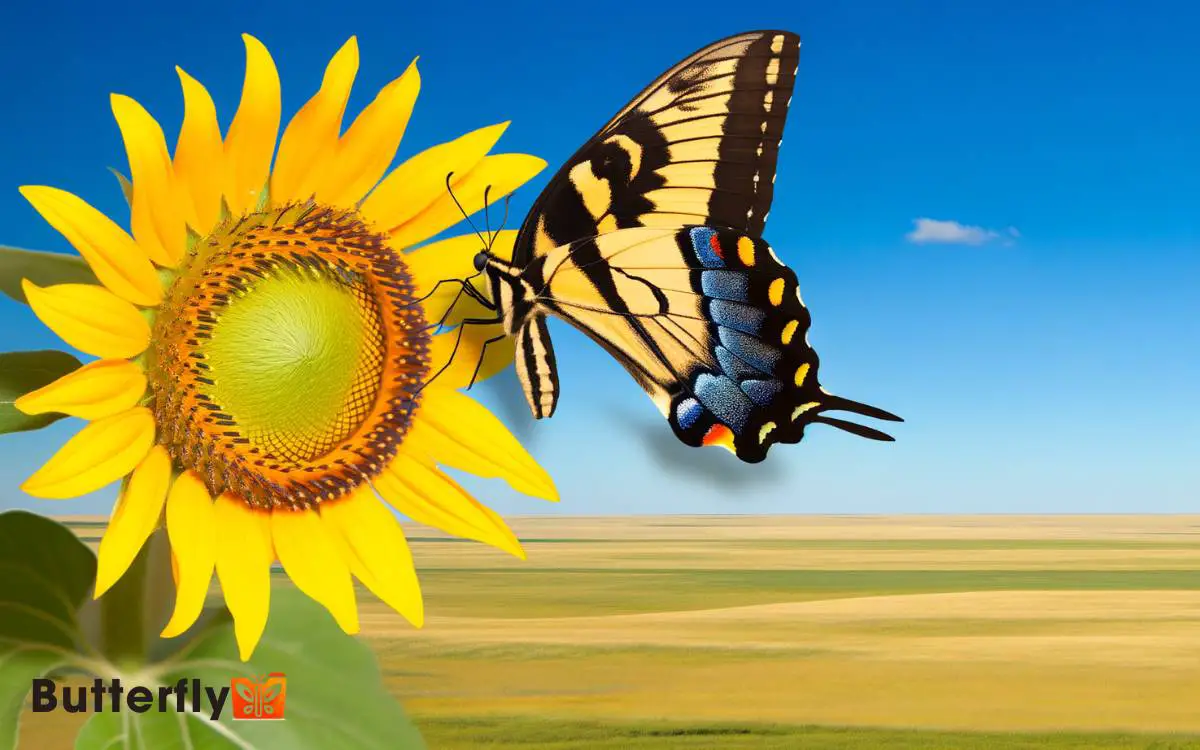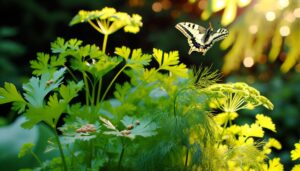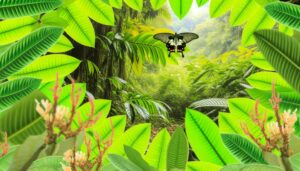Eastern Tiger Swallowtail Butterflies Kansas: Observation!
The Eastern Tiger Swallowtail butterfly, easily recognized by its yellow and black striped wings, thrives throughout Kansas.
They inhabit deciduous forests, river valleys, and suburban gardens, favoring areas rich in nectar sources like milkweed and wild cherry. These butterflies exhibit distinct sexual dimorphism; females have more blue scaling on their hindwings.
Observers can spot them from late spring to early summer, especially in places like Tallgrass Prairie National Preserve. Their life cycle from egg to adult includes stages where larvae mimic false eyespots for protection.
For an in-depth understanding of their behavior and conservation efforts, there’s much more to discover.

Key Takeaways
Identification and Appearance
The Eastern Tiger Swallowtail‘s identification hinges on its striking yellow and black striped wings, which exhibit a distinctive pattern that aids in distinguishing it from other species.
The forewings are primarily yellow with four black bands, while the hindwings are adorned with blue and orange spots near their edges.
Sexual dimorphism is evident; females often display more extensive blue scaling on the hindwings compared to males.
The wingspan ranges from 3.1 to 5.5 inches, making it one of the larger North American butterflies. Antennae are black with white tips, enhancing its sensory capabilities.
The body is similarly striped, matching the wing pattern, ensuring camouflage and signaling prowess. Observations reveal that these markings serve as both predator deterrents and mating signals.
Habitat Preferences
Eastern Tiger Swallowtails thrive in deciduous forests, river valleys, and suburban gardens, showcasing their adaptability to various environments.
Their presence is most prolific in areas rich in nectar sources like milkweed, joe-pye weed, and wild cherry.
Observations indicate a preference for habitats offering both sunlit clearings for thermoregulation and shaded peripheries for protective cover.
They’re commonly found near water sources, which provide ideal conditions for puddling behavior a process where they extract essential minerals from moist soil. Their adaptability extends to urban landscapes, where they capitalize on cultivated flowers.
By exploiting diverse habitats, Eastern Tiger Swallowtails secure their survival and proliferation, reflecting their remarkable resilience and ecological versatility. This adaptability makes them a familiar and celebrated sight across Kansas.
Life Cycle Stages
The life cycle of the Eastern Tiger Swallowtail in Kansas encompasses four distinct stages: egg, larva, pupa, and adult butterfly.
Females oviposit pale green eggs on host plants like wild cherry and tulip trees, which hatch into caterpillars exhibiting characteristic eyespots.
After several instars, the larva forms a chrysalis, eventually emerging as a striking yellow and black butterfly.
Egg to Larva
From the moment a female Eastern Tiger Swallowtail deposits her eggs on host plants like wild cherry or tulip tree, the journey of transformation begins. These spherical, green eggs are laid singly on the leaves and hatch within 4-10 days.
Upon hatching, the first instar larva emerges, resembling bird droppings a clever camouflage against predators. As the larva progresses through five instars, it consumes voraciously, growing larger with each molt.
By the fifth instar, it sports a striking green body adorned with false eyespots, mimicking a snake’s head to deter threats. This stage is important for accumulating energy reserves, preparing the larva for the next transformation.
Throughout this process, observational data reveal meticulous growth and adaptive strategies.
Pupa to Butterfly
After the larva achieves full growth, it forms a chrysalis, entering the pupal stage where remarkable metamorphosis occurs, transforming it from caterpillar to butterfly.
During this stage, the Eastern Tiger Swallowtail undergoes significant physiological changes. Enzymes break down larval tissues, and cells reorganize into adult structures.
Key observations include:
- Chrysalis Color: The chrysalis can be green or brown, providing camouflage against predators.
- Duration: The pupal stage typically lasts 10-20 days, depending on environmental conditions.
- Emergence: The adult butterfly, or imago, emerges with crumpled wings that expand and harden within hours.
This process highlights the complexity of insect development and the intricacies of nature, inspiring awe and a sense of freedom in those who witness it.
Feeding Habits
Feeding primarily on nectar, Eastern Tiger Swallowtail butterflies exhibit a preference for flowering plants such as milkweed, Joe-Pye weed, and wild cherry blossoms. Their proboscis, a specialized mouthpart, allows them to extract nectar efficiently from tubular flowers.
These butterflies are diurnal feeders, actively seeking out nectar sources during daylight hours. Observational data indicate that they frequent habitats rich in diverse flora, enhancing their foraging opportunities.
Additionally, they occasionally engage in mud-puddling, where they obtain essential minerals and salts from moist soil. This behavior is particularly noted in males and is essential for their survival.
Mating and Reproduction
The Eastern Tiger Swallowtail exhibits intricate courtship behavior patterns, including aerial displays and pheromone release to attract mates.
Females lay their eggs singly on host plants like wild cherry and tulip tree, ensuring ideal conditions for larval development.
Observations indicate that egg-laying typically occurs on the undersides of leaves, providing necessary protection from predators and environmental factors.
Courtship Behavior Patterns
Male Eastern Tiger Swallowtail butterflies perform intricate aerial displays and emit pheromones to attract potential mates, initiating the courtship process.
Their flight patterns are characterized by rapid ascents, hovering, and sudden dives. Females exhibit selective behavior, often evaluating multiple suitors before choosing a mate.
Observational data highlight several key behaviors:
- Wing Fluttering: Males vibrate their wings at high frequencies to release pheromones.
- Pursuit Flights: Males chase females in dynamic, spiraling flights.
- Perching: Males and females perch together briefly, allowing closer interaction.
These behaviors are essential for successful mating, ensuring genetic diversity within the population. Understanding these patterns offers insight into the complex mating rituals of one of Kansas’s most vibrant butterfly species.
Egg Laying Process
Once mating concludes, females meticulously select host plants where they’ll lay their eggs, guaranteeing ideal conditions for larval development.
They often choose deciduous trees like wild cherry, tulip trees, and ash. The eggs are spherical, pale green, and approximately 1mm in diameter.
Observations reveal that females exhibit a probing behavior, testing leaf surfaces before committing to egg deposition.
| Host Plant | Observed Behavior |
|---|---|
| Wild Cherry | Probes leaf surface, deposits single egg |
| Tulip Tree | Prefers younger leaves, guarantees sunlight exposure |
| Ash | Selects leaves close to the ground |
| Sweetbay Magnolia | Often chooses shaded leaves |
| Birch | Lays eggs on leaf undersides, avoids predators |
Each choice reflects an evolutionary strategy to optimize larval survival, balancing predation risk and nutritional needs.
Seasonal Patterns
During early spring in Kansas, Eastern Tiger Swallowtail butterflies emerge from their chrysalises, marking the start of their annual life cycle. These butterflies are a harbinger of the seasonal change, displaying vivid yellow and black markings.
Observations indicate several key behaviors:
- Nectar Feeding: They frequent flowering plants, particularly those with tubular flowers rich in nectar.
- Mate Searching: Males actively patrol territories, seeking females for reproduction.
- Oviposition: Females lay eggs on host plants such as wild cherry and willow.
As temperatures rise, their activity peaks, correlating with increased floral abundance. By late summer, a second generation often appears, ensuring population continuity. This cyclical pattern underscores their adaptability and synchrony with Kansas’ seasonal dynamics.
Migration in Kansas
Eastern Tiger Swallowtail butterflies in Kansas exhibit distinct seasonal movement patterns influenced by temperature gradients and precipitation levels.
Observational data indicate that these butterflies prefer riparian habitats and deciduous woodlands during their migration.
Weather conditions, particularly late spring frosts and summer droughts, profoundly affect their migratory behavior and habitat selection within the region.
Seasonal Movement Patterns
Researchers have observed that Eastern Tiger Swallowtail butterflies exhibit distinct seasonal migration patterns in Kansas, influenced by temperature variations and the availability of nectar sources.
These butterflies migrate northward in spring as temperatures rise and flowers bloom, providing essential nectar.
- During summer, they spread across Kansas, populating gardens, woodlands, and meadows.
- As temperatures drop, they migrate southward or seek warmer microhabitats within Kansas.
- The migration isn’t just a random movement but a well-timed journey ensuring the species thrives.
Weather Influence Factors
Temperature fluctuations and weather patterns play a major role in dictating the migration routes and timing of Eastern Tiger Swallowtail butterflies within Kansas.
When temperatures rise in early spring, these butterflies emerge from their pupal stage, initiating their migratory journey. Sudden cold snaps can delay their movement, while consistent warm spells promote earlier migrations.
Rainfall also impacts nectar availability, essential for their energy needs during migration. Observations indicate that dry spells can lead to reduced butterfly sightings, as they may seek regions with better floral resources.
Wind patterns further influence their flight paths, with strong headwinds potentially diverting them from their anticipated routes.
Therefore, Kansas’ dynamic weather significantly affects the Eastern Tiger Swallowtail’s migratory behavior and success.
Habitat Preferences Trends
Understanding the habitat preferences of Eastern Tiger Swallowtail butterflies during their migration in Kansas reveals a distinct preference for deciduous woodlands interspersed with flowering meadows.
These butterflies are frequently observed utilizing the following environments:
- Riparian zones: They favor areas along rivers and streams, where moisture and plant diversity are abundant.
- Boundary habitats: Border zones between forests and open areas provide diverse floral resources and shelter.
- Urban green spaces: Parks and gardens with native flowering plants can support their nectar needs.
Observational data indicates that these habitats offer ideal conditions for feeding and reproduction. The presence of host plants like wild cherry and tulip trees in these areas is essential. This detailed understanding aids in conservation efforts, ensuring these migratory pathways remain viable and vibrant.
Best Viewing Locations
Prime locations for observing Eastern Tiger Swallowtail butterflies in Kansas include the rich, biodiverse habitats of the Tallgrass Prairie National Preserve and the wooded areas of the Flint Hills. These butterflies are often seen flitting among wildflowers, especially near open meadows and forest edges where nectar sources are abundant. While Kansas provides excellent habitats, enthusiasts can also find eastern tiger swallowtails in Nebraska, particularly in wooded river valleys and prairies. Their striking yellow and black wings make them easy to spot as they gracefully glide through the landscape.
These regions provide the nectaring plants such as milkweed and thistle that these butterflies favor.
Observers often report sightings near water sources where adults gather to drink and extract minerals, a behavior known as puddling.
The Flint Hills, with its mix of open prairies and forested sections, offers an ideal environment for both caterpillars and adults. Additionally, the Tallgrass Prairie’s abundance of wildflowers supports robust butterfly populations.
Best viewing typically occurs during the late spring to early summer when the butterflies are most active and the vegetation is lush.
Conservation Efforts
While enjoying the vibrant presence of Eastern Tiger Swallowtail butterflies in these prime Kansas locations, one must also consider the ongoing conservation efforts that guarantee their habitats remain hospitable.
Conservationists in Kansas employ a variety of strategies to protect these delicate creatures. They focus on:
- Habitat Restoration: Rehabilitating native plant species that provide essential nectar sources and host plants for larvae.
- Pollution Control: Implementing measures to reduce pesticide use and mitigate water pollution, ensuring a cleaner environment.
- Community Engagement: Educating local communities about the importance of butterfly conservation and encouraging citizen science projects.
These efforts, supported by scientific research and observational data, safeguard that Eastern Tiger Swallowtails continue to thrive, allowing future generations to enjoy their beauty and ecological benefits.
Interesting Facts
Eastern Tiger Swallowtail butterflies, scientifically known as *Papilio glaucus*, exhibit sexual dimorphism, with females often displaying a distinctive blue wash on their hind wings, unlike the primarily yellow males.
These butterflies are strong fliers, capable of covering vast distances in their search for nectar from a variety of flowering plants. They utilize a unique proboscis to feed, coiling it when not in use.
Caterpillars of this species mimic bird droppings in early stages, evolving to a bright green with eye spots as they mature, deterring predators.
Remarkably, the Eastern Tiger Swallowtail can thermoregulate by basking in the sun, adjusting their wing positions to maximize heat absorption.
Adults typically live for about two weeks, contributing to multiple generations annually.
Photography Tips
Capturing the vibrant colors and delicate details of Eastern Tiger Swallowtail butterflies requires a combination of patience, the right equipment, and keen observational skills.
Photographers should use a macro lens to highlight the intricate patterns on the butterfly’s wings and a fast shutter speed to freeze their rapid movements. Observing their behavior is essential; these butterflies often return to the same feeding spots.
- Natural Lighting: Shoot during early morning or late afternoon for softer, diffused light.
- Steady Hands or Tripod: Reduces motion blur, important for capturing the fine details.
- Background: Ensure a clean, contrasting background to make the butterfly stand out.
Conclusion
The Eastern Tiger Swallowtail butterflies in Kansas symbolize the delicate balance of nature’s intricate dance.
With their striking yellow and black wings fluttering through verdant woodlands and flowering meadows, they embody the beauty and complexity of ecological interactions.
Observers are reminded that each stage of their life cycle, from egg to adult, is a proof of nature’s resilience. By conserving their habitats, we guarantee these living jewels continue to grace our landscapes for generations to come.






